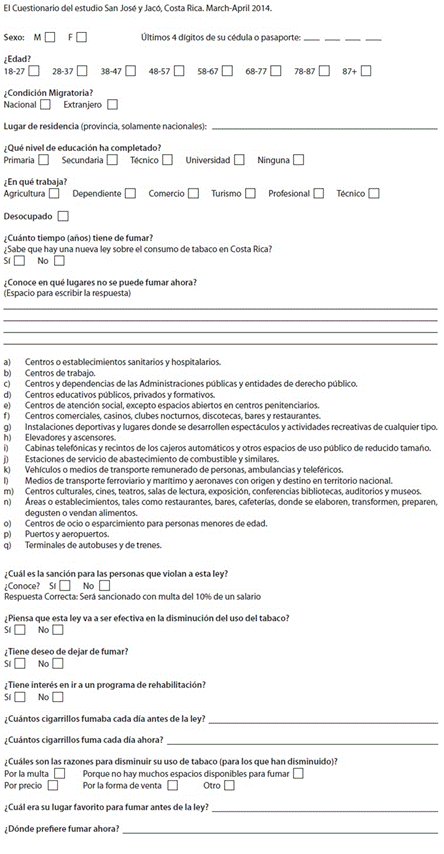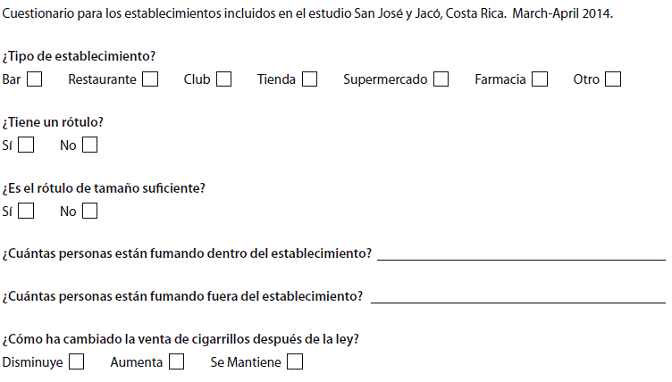According to the World Health Organization, tobacco use is the single most preventable cause of death in the world. Claiming over five million lives a year worldwide, tobacco use has been linked to numerous health problems including heart disease as well as lung, tracheal, and bronchus cancers. In fact, 11% of all heart disease cases and 70% of lung, tracheal, and bronchus cancers are directly caused by tobacco use. The health risks associated with tobacco use are so prevalent that up to half of the world's one billion smokers will die prematurely from tobacco related diseases (WHO, 2014).
In an effort to combat the deadly effects of tobacco use, as well as the economic toll that is a byproduct of the deteriorating health of the world's smokers, many countries have begun to enact public smoking bans in an effort to decrease the amount of tobacco consumed, as well as to protect their non smoking citizens from the effects of second-hand smoke. On March 26, 2012, Costa Rica put into effect a law prohibiting smoking in public places, as well as in outdoor spaces occupied by the general public in an attempt to lower the prevalence of smoking in the country (Asamblea Legislativa, Ley N˚ 17.371). According to data taken by the Institute of Alcoholism and Pharmaceutical Dependency (IAFA) in 2005, the average smoker in Costa Rica started when they were 16 years old. In Costa Rica, 54% of the population had reported smoking at some point during their life. Of the smoking population, 60% smoked an average of 10 to 12 cigarettes every day. Furthermore, about half of the smoking population smoked at their place of employment (IAFA, 2005). With the high prevalence of tobacco use in the country, further research is necessary to see if the new law has effectively decreased tobacco use in the country.
There is a precedent of these types of national smoking bans in many different countries around the world. Research has been conducted to determine the effectiveness of these bans. In Germany (Anger, Kvasnika, & Siedler, 2011), Australia (Anger et. al, 2011), Italy (Pieroni, Chiavarini, Minelli, & Salmasi, 2013), and Scotland (Ashley, Saunders, Mullard, Prasad, Mariner, & Williamson, 2011), only a minimal decrease of smoking was found after the implementation of their anti tobacco legislation. A study in Canada found a more significant decline in tobacco use (Lemstra, Neudorf, & Opondo, 2008). These studies were also able to draw correlations between different populations and changes in smoking habits.
The objectives of my survey were to determine: a) knowledge and attitudes of Costa Rican smokers about the new law concerning tobacco consumption in Costa Rica, b) how a person's smoking habits have changed since the implementation of the law, c) if local establishments are in compliance with the new law and d) if local venders have noticed a significant change in tobacco sales.
Methods
Study Area:This study took place over two months in the provinces of San José and Puntarenas, Costa Rica. In San José the study was carried out around the University of Costa Rica on a local street called the Calle de la Amargura (9˚56'N, 84˚5'W). This street consists of bars, copy stores, and small restaurants, and is very popular with the students from the University. The research was also conducted in Jacó, a rural tourist town on the central Pacific coast (9˚62' N, 84˚63'W). This location was chosen because of its proximity to the Ministry of Health office, as well as because of the large prevalence of bars and restaurants that have historically attracted smokers.
Study Population:This study included current smokers over the age of 18 that gave oral consent to participate in the survey and random local establishments.
Procedure:Establishments were chosen by selecting a random starting point and taking data on every successive establishment along the street. For the establishment data, I entered the chosen establishments to verify if they had the required no smoking signs of the correct size, and if people were smoking inside the establishment. If the establishment was one that sold cigarettes an employee was asked if they had noticed a change in cigarette sales after the implementation of the new law (Appendix B). Furthermore, a series of interviews with smokers was conducted. Both residents and non residents of these two areas were interviewed. The researcher walked the streets of the two locations looking for people actively smoking. These people were then approached and asked if they would be willing to participate in the research. Oral consent to participate in the survey was given by every participant, they were also offered the opportunity to give the researcher the last four digits of the person's cédula or passport so that their data could be encountered and removed later if they wished. The researcher used a questionnaire that gave each interviewee a select number of choices to pick from in order to allow for quantitative analysis; all responses were verbal (Appendix A). The participants were asked basic questions such as age, occupation, educational level, and residence. The researcher then asked questions to ascertain the participants' knowledge and attitude about the new law. The participants then answered questions on their daily tobacco use and any changes that they had noticed after the new law, as well as their thoughts on quitting. The proposal for this study was approved by the ACM ethics panel and I followed a Plan for Protection of Human Research Subjects.
Data Analysis:I used three parametric, one-way ANOVAs to estimate differences in mean: 1) "number of cigarettes consumed per day" between "desire to quit or not to quit"; and 2) "percentage of places known where not to smoke" between: a) gender, and b) educational level. I used parametric, two-way ANOVAs to estimate differences in mean "number of cigarettes consumed per day" between "before" and "after" passage of smoking law and a) gender, b) age groups, c) years smoking,d) occupation, e) educational level, f) type of smoker, and g) knowledge of existence of smoking law. I used a paired comparisons two-way ANOVA to estimate difference in mean "number of cigarettes consumed per day" between the same interviewees "before" and "after" passage of the smoking law. A posteriori comparisons between means were carried out with Least Significant, Tukey or Scheffe tests. Statistical procedures followed Sokal and Rohlf (1995). Statistical analysis was completed with Statgraphics Centurion XV Version 15.1.02 (Statpoint Technologies, Inc.).
Results
Participants:A total of 150 interviews were conducted, 75 in San José and 75 in Jacó. There were 54 establishments used in the investigation, 27 in San José and 27 in Jacó.
Demographics:Of the people interviewed 31.33% were female and 68.67% were male. From all of the participants studied, 48% were 18-27 years old, 26% were 28-37 years old, 11.33% were 38-47 years old, 7.33% were 48-57 years old, and 7.33% were 58-67 years old. The migratory status of those interviewed was 68.67% nationals and 31.33% foreigners. Of those who were national born Costa Ricans, 7.77% were from Alajuela, 1% were from Guanacaste, 5.83% were from Heredia, 64.08% were from San José, 14.56% were from Puntarenas, and 6.80% were from Cartago. Persons who only completed primary school made up 11.33% of those surveyed, 32.67% finished secondary school, 3.33% completed a technical school, and 52.76% completed university studies. Of those surveyed, 1.33% said they worked in agriculture, 9.33% worked in a commercial business, 22% were clerks or salespeople, 14% were unemployed, 18.67% were students, 0.67% worked independently, 14% were professionals, 12.67% were in some sort of technical field, and 7.33% worked in tourism.
Smoking history: Very few of the participants had been smoking for less than a year. Most had been smoking for 1-5 years with a steady decrease in participants up to the 16- 20 year group. There were very few participants in the subsequent groups which went all the way up to 50 years of smoking (Figure 1). Across all participants, 62% expressed a desire to quit smoking with 38% claiming no interest. Also, 74% of people were not interested in a rehabilitation program to quit smoking while 26% were interested.
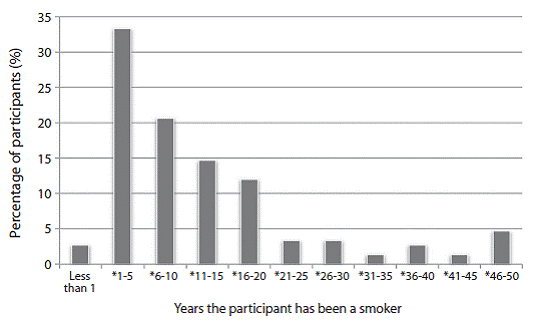
Figure 1: Duration of Smoking Habit of Participants Interviewed in San José and Jacó, Costa Rica, March-April, 2014.
Law Knowledge and Attitudes: Only 13.33% of those interviewed did not have any knowledge of the law, with 86.67% claiming some level of knowledge concerning the new tobacco legislation. Of those who had knowledge about the new law a few could not identify any places in which it was prohibited to smoke. Most participants knew only one place. About the same number of participants knew two or three places, with subsequently less participants in the following knowledge levels (Figure 2). As far as the penalty for smoking in a prohibited place, 68% of all participants did not know what the penalty was and only 32% were able to accurately describe the fine. Finally, 56.06% of participants believed that the new law would not be effective in decreasing smoking. Only 43.94% of participants believed that this new legislation would cause a decrease in smoking in Costa Rica.
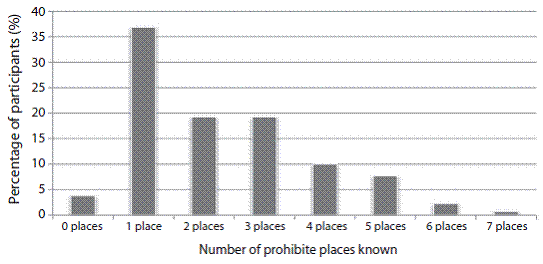
Figure 2: Knowledge of Prohibited Smoking Places of New Tobacco Law of Participants Interviewed in San José and Jacó, Costa Rica, March-April, 2014.
Education and Knowledge of the law: The number of prohibited smoking locations the participant could name increased with an increase in educational level of the interviewee from primary (x = 1.35) to secondary ̅ school (x = 1.71). A slight decrease in knowledge was ̅ shown for those who completed technical school (x = ̅ 1.4). Persons who completed university were significantly more knowledgeable (x = 2.35) than all other educa-̅ tion levels (F=3.04; DF= 3, 146; p=0.03).
Gender and Knowledge of the law: With respect to gender, male participants were significantly more knowledgeable about the places in which it is prohibited to smoke than their female counterparts (F=5.46; DF= 1, 298; p=0.02) (Figure 3).
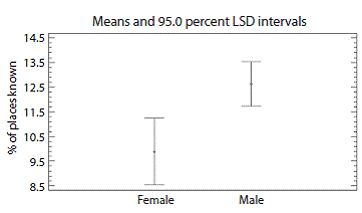
Figure 3: Difference in Law Knowledge Level of Male and Female Participants, Interviewed in San Jose and Jaco, Costa Rica, March-April, 2014.
Overall decrease in Smoking: Mean number of cigarettes consumed per day for all interviewees slightly decreased after the implementation of the new law (x = ̅ 12.12 to 11.24). However, the decrease was not statistically significant (F= 1.14; DF= 1, 146; p= 0.29)
Reasons for decreasing Smoking: Of those who claimed to have diminished their use of tobacco products, only 7.33% claimed that the new smoking ban was the main motivating factor. The other 92.67% selected the category 'other reasons' and cited various health and family commitments.
Gender and Change in Tobacco Use: Male participants smoked a significantly larger quantity of cigarettes than females overall both before and after the smoking ban (F= 11.69, DF= 1, 290; p= 0.0007). However, there was not a significant change in the number of cigarettes consumed per day after the tobacco ban for either males or females (F= 0.07; DF= 1, 290; p= 0.80) (Figure 4).
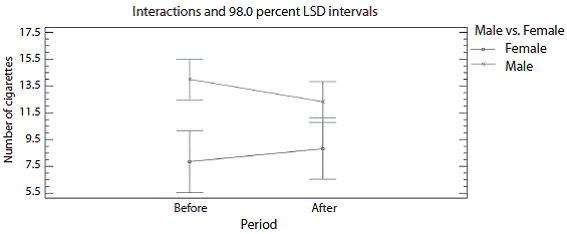
Figure 4: Difference in Tobacco Consumption of Male and Female Participants, Interviewed in San Jose and Jaco, Costa Rica, March-April, 2014.
Years of Smoking and Change in Tobacco Use: There was a steady increase in the number of cigarettes smoked per day as the number of years the participant had smoked increased (F= 18.30; DF= 5, 282; p<0.0001).
There was not a significant change in the amount of cigarettes smoked before and after the law for any of the groups (F= 26.74; DF= 1, 282; p= 0.60) (Figure 5).
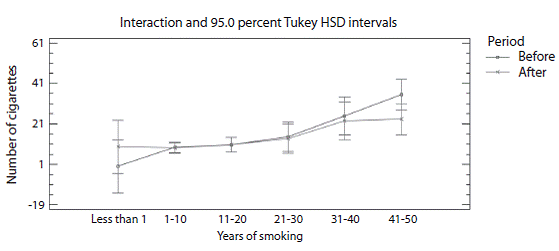
Figure 5: Difference in Tobacco Consumption of Participants of Different Addiction Durations, Interviewed in San Jose and Jaco, Costa Rica, March-April, 2014.
Age Group and Change in Tobacco Use: The mean number of cigarettes per day increased similarly through the first four age groups. However, the fifth age group showed a much greater use of cigarettes before than after the law. The oldest age group showed a strongly decreased usage both before and after (F= 12.93; DF= 4, 284; p<0.0001). The mean number of cigarettes did not significantly change before and after the new law for any age groups (F= 2.13; DF= 1, 284; p= 0.15) (Figure 6).
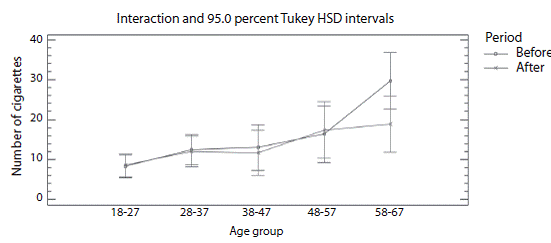
Figure 6 Difference in Tobacco Consumption of Participants of Different Age Groups, Interviewed in San Jose and Jaco, Costa Rica, March-April, 2014.
Employment and Change in Tobacco Use: There was no significant tendency found between the type of occupation of the participants and their change in cigarettes consumed per day before and after the law (F=0.15; DF=1, 276; p=0.70). There were significant differences in the number of cigarettes consumed per day between different types of jobs, with students having one of the lowest means of tobacco consumption (x = 7.88) and ̅ tourism workers having one of the highest means of tobacco consumption with (x = 19.89) (F=3.46; DF= 7, 278; ̅ p= 0.0014).
Education and Change in Tobacco Use: There was no significant tendency found between the level of education that a participant had obtained and their change in cigarettes consumed per day before and after the law (F= 0.81; DF= 1, 286; p=0.37). There was a significant difference in the number of cigarettes consumed per day between different educational levels with those who completed technical school having the lowest mean of cigarette consumption (x = 5.45) and those who completed secondary school having the highest mean of cigarette consumption (x = 14.20) (F=4.39; DF= 3, 286; ̅ p=0.0049).
Desire to Quit Smoking and Change in Tobacco Use: The participants who indicated a desire to quit smoking were shown to smoke more cigarettes each day (x = 13.66) than those who did not want to quit (x̅ = 8.54) ̅ (F= 15.20; DF= 1, 290; p= 0.001). There wasn't a significant change in number of cigarettes smoked per day after the law for either group (F= 0.11; DF= 1, 290; p= 0.74).
Type of Smoker and Change in Tobacco Use: There was a slight increase in the amount of cigarettes smoked per day for the participants identified as light smokers (0-5 cigarettes a day). The medium smokers (5- 15 cigarettes a day) did not have a significant change between periods. Persons identified as being heavy smokers showed a significant decrease in number of cigarettes consumed per day after the law (F= 1.76; DF= 1, 288; p= 0.19) (Figure 7).
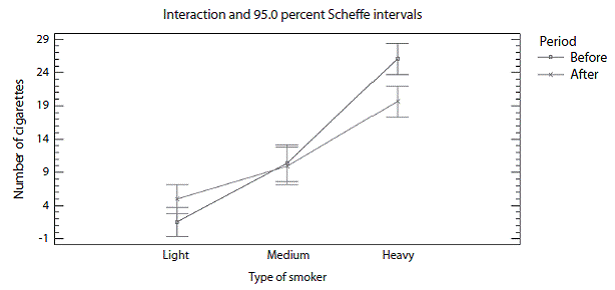
Figure 7: Changes in Smoking Habits Between Different Types of Smokers, Interviewed in San José and Jacó, Costa Rica, March-April, 2014.
Knowledge of law and Change in Smoking: The participants who knew about the new law smoked a significantly larger amount of cigarettes per day than those that did not have knowledge of the law (F=21.25; DF= 1, 290; p<0.0001). There was not a significant change in number of cigarettes consumed per day for either group (F=1.11; DF=1,290; p=0.29) (Figure 8). Furthermore, as participants' knowledge level of prohibited smoking places rose it did not cause a significant decrease in the number of cigarettes smoked per day (F= 0.01; DF= 1, 278; p= 0.92).
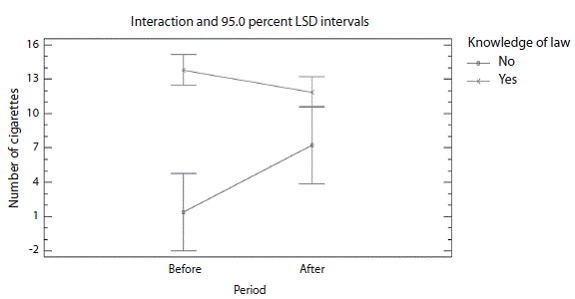
Figure 8: Comparison of Smoking Level and Law Knowledge of Participants, Interviewed in San José and Jacó, Costa Rica, March-April, 2014.
Establishment data: Of all the establishments I entered 81.48% had the required no smoking sign. Every establishment that had a no smoking sign had one of the correct size and coloring. None of the establishments had patrons smoking inside. Only 17.86% of the establishments sold cigarettes and of those 13.33% saw an increase in sales, 53.33% saw a decrease, and 33.33% did not see any change.
Discussion
The overall findings of this research are very similar to studies that have been conducted worldwide on the effectiveness of tobacco bans on the smoking population. The effectiveness of the new tobacco legislation in Costa Rica in decreasing the use of tobacco products has been minimal with an average decrease of about one cigarette a day. This is on par with other countries that have implemented similar types of legislation. In the case of the nation-wide public smoking ban in Germany, the research showed that amongst the general smoking population there was not a significant decrease in the use of tobacco products (Anger et. al, 2011). However, there were subgroups of the general smoking population that were affected more than others.
Type of Smoker and Change in Tobacco Use: The research showed that in Costa Rica heavy smokers were significantly decreasing their consumption of tobacco by about six and a half cigarettes a day, with medium smokers maintaining their same smoking habits and light smokers slightly increasing their consumption by about four cigarettes a day. These findings coincided with those of a team in Australia that conducted research focused on the effects of smoking bans in the workplace. Their findings showed that there was only a 1% decrease in smoking after the ban was put into place, with the heavy smokers being most affected (a decrease of 8 cigarettes a day) and the light smokers being the least affected (no change) (Borland, Chapman, Owen, & Hill, 1990). The slight increase in cigarette consumption seen in the light smokers could be caused by the new form of cigarette sales in Costa Rica which require consumers to purchase cigarettes in packs of 20 now as opposed to the one and three packs that were offered before the law.
Employment and Change in Tobacco Use: When looking at other subpopulations, there seemed to be very little relationship between various demographic data and a decrease in smoking. In the instance of job type and decrease in smoking habits, the research showed that there was no significant tendency between the two. Interestingly, a study in Italy found that their ban was more effective in reducing smoking amongst the employed population as opposed to those who did not have permanent employment (Pieroni et al., 2013). My findings did not see this same tendency. This could be because of the fact that smoking in an office setting was never as popular in Costa Rica. My research found that only 3.33% of people listed work as their favorite place to smoke before the new legislation. This could account for the differences, and also be a part of the reason why the smoking ban has not been very effective.
Education and Change in Tobacco Use: When looking at the link between education level and changes in smoking habits, my data showed that there wasn't a strong correlation between a certain education level and diminishing tobacco use. However, in the study from Italy, they found that less educated people were more likely to be more effected by this law than people who had a higher degree of education (Pieroni et al., 2013). My research was able to ascertain that persons who only completed primary or secondary school smoked a lot more than those who went on to technical school or university. As I have previously discussed that heavy smokers were more likely to have decreased their smoking after the law, this could account for some of the findings in Italy and may have shown in my results with a bigger sample size.
Knowledge of law and Change in Smoking: My research was unable to find a significant tendency between age group and desire to quit smoking with a change in smoking habits after the law passed. There was however, a tentative linkage between knowledge of the law and a decrease in smoking. Those who knew about the existence of the law slightly decreased their smoking in comparison to those who did not know anything about the law. However, it is unclear whether this tendency is because of the knowledge of the law directly, or is because of the fact that those who knew about the law were more heavy smokers than those who didn't.
As far as knowledge of the tobacco law, it was found that significantly more men than women knew about the existence of the law. This could be contributed to the fact that male participants tended to smoke more on average than women participants. Also, there was an increase in the depth of knowledge about the law as the education level of the participants increased. Unfortunately, most participants had only a very basic understanding of the new legislation and furthermore, a deeper understanding of the law did not lead to a decrease in smoking.
Reasons for decreasing Smoking: For the few people who did decrease their use of tobacco after the enactment of the new anti tobacco legislation, only 7.33% of them claimed that the new law was directly responsible for their decrease in smoking. Most participants cited health reasons. In the results of surveys given to residents of Saskatoon, Canada, 23.5% asserted that they had reduced the amount they were smoking per day as a direct result of the law (Lemstra et al., 2008). The difference between these two findings could be contributed to the environment of the two research sites. While Canadians would have to endure cold to smoke outside, for Costa Rica the climate outside an establishment is basically the same. This could be one of the reasons the law in Costa Rica is unable to cause substantial change. However, Costa Rica is also running television ads and using other propaganda to warn against the health dangers of smoking and encourage people to quit smoking. This could be influencing smokers and causing the decrease in smoking that is attributed to a desire for better health.
Establishments: My findings show that establishments are in almost complete compliance with this law and the prevalence of smoking in forbidden areas is extremely minimal. This is congruent with a study from Scotland. Their findings showed that as time went on less and less smokers were smoking in prohibited establishments with nearly none smoking inside after six months (Ashley et al., 2011). This in conjunction with the lack of an overall decrease in smoking suggests that the smoking ban in Costa Rica may not be able to play a large role in limiting tobacco use as even while most everyone is in compliance; it is not affecting the smoking habits of the population.
Limitations: The methodology of this research did not allow for me to speak to anyone who had recently quit smoking. This could have added to data supporting the effectiveness of the law. There was also a problem in communication between myself and some of the participants of lower educational status. This along with general false answers could have skewed the data. Finally, I was unable to enter all the establishments in my two locations, and only asked for estimations of changes in sales, both of which limited my data.
Future Studies: As this law is relatively new there is much more that can be done in the way of research. One project that could be done is an investigation into the effect of health propaganda and education on smokers in Costa Rica, to ascertain if this plays a bigger role than legislation. It could also be useful to interview young smokers and non- smokers, over the legal age, to see what their knowledge and attitudes are concerning this law as one of its major aims is to diminish the number of young people who begin to smoke.












 uBio
uBio 
